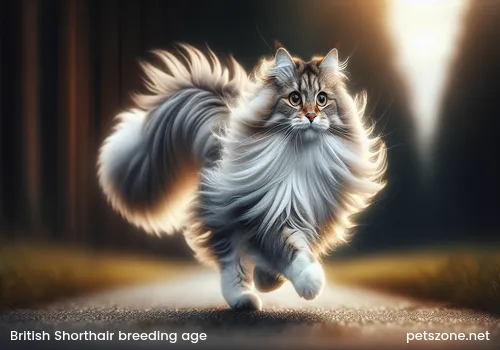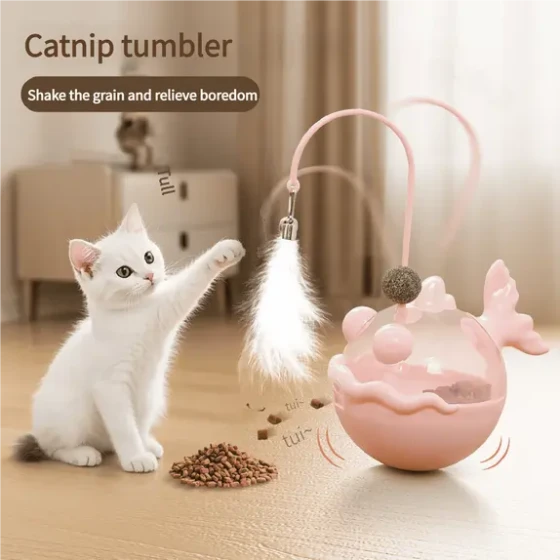How old can British Shorthair cats breed_Best breeding age and precautions
How old can British Shorthair cats breed? Understand the best breeding age and key precautions

For owners who want to "matchmake" their British Shorthair cats and consider breeding offspring, it is crucial to know when cats reach sexual maturity, when the best breeding age is, and the precautions involved. Simply put, although cats might experience their first heat at 4-6 months old, this does not mean they are ready for reproduction. Generally, the best breeding age for female cats is between 1 and 5 years old, while male cats are recommended to breed after 1 to 1.5 years, which helps ensure the health of the cats and the quality of their offspring.
Adolescent excitement: When do cats reach sexual maturity?
Like humans, cats also go through puberty. This stage marks the development of their gonads and the ability to reproduce. Most cats reach sexual maturity between 4 months and 1 year old, but this is influenced by breed, physique, weight, and lighting conditions.
- Female cats: Usually come into heat for the first time at 5 to 6 months old, meaning their ovaries start ovulating. Short-haired breeds (such as our British Shorthair or similar short-haired cats) may come into heat earlier, around 4-6 months old. Long-haired breeds may come into heat later, typically at 10-12 months. Females’ heat cycles generally last 4-7 days; if not mated, they will heat again about every 2-3 weeks, especially during longer light periods in the breeding season (usually spring through autumn). During heat, female cats become unusually “passionate,” may vocalize loudly (sometimes sounding like “singing” or “howling”), become clingy, roll on the floor, or raise their hindquarters and tilt their tails to one side to attract males.
- Male cats: Males typically reach sexual maturity slightly later than females, around 6 to 12 months old. Some sources even recommend waiting until about 1.5 years old for full maturity. Sexually mature males may show some “tough guy” behaviors, such as spraying urine to mark territory, louder vocalizations, and increased restlessness as they seek mates.
It’s worth mentioning that cats are "induced ovulators." This means females usually need the stimulus of mating to trigger ovulation, which differs from many mammals that ovulate spontaneously during heat.
"Wait, not the best time yet!": Sexual maturity does not equal suitability for breeding
Although cats can reproduce once sexually mature, like newly adult humans, their bodies and minds may not be fully prepared for breeding. Breeding cats too early may bring risks and problems.
Why is early breeding not recommended?
- Incomplete physical development: Young cats’ bones, muscles, and internal organs may still be developing. Early pregnancy and birth will consume much energy and nutrients, impacting their growth and potentially causing premature aging and shorter lifespan in females.
- Increased risk of difficult births: Especially for females, an undeveloped pelvis may lead to dystocia. Overly large or numerous fetuses can also raise the risk of difficult labor.
- Offspring health issues: Early breeding might result in offspring with delayed development, weaker constitution, low survival rates, or increased health problems and breed deterioration. For males, early breeding can affect sperm quantity and quality, impacting offspring health.
- Insufficient maternal/paternal care: Young cats may not know how to care for their kittens properly, leading to neglect or abandonment.
- Behavioral problems: For males, early or excessive breeding can cause stress and increased aggression or other behavioral issues.
Grasping the "golden age": Best breeding time for British Shorthair cats
Overall, to ensure the cat’s health and quality of offspring, it is recommended to breed only after physiological maturity is reached.
- Female cats: The best breeding age is usually between 1 and 5 years. Some opinions suggest breeding short-haired cats after 12 months old is appropriate, while long-haired cats might need to wait until 18 months old. It’s not recommended to breed the first heat; waiting until the second or later heat cycles when the cat’s body is more mature is better.
- Male cats: Recommended to breed after 1 to 1.5 years. Although some males can reproduce at 6 months, waiting until 12-18 months ensures the reproductive system is more mature and sperm quality and quantity are better, which is beneficial for healthy offspring.
Within this optimal age range, the cat’s body is mostly developed and better able to handle pregnancy and nursing, with more experience caring for kittens.
Essential preparation: Precautions before breeding
Deciding to breed British Shorthair cats requires serious attention; it’s more than just putting two cats together—it entails much preparation and precautions.
- Health check: Before breeding, both males and females must undergo a comprehensive health examination at a veterinary clinic, including but not limited to:
- Vaccinations and deworming: Ensure both cats are within their immunity period and have had internal and external parasite treatments.
- Genetic disease screening: For purebred cats, screening for common hereditary diseases is recommended to avoid passing potential illnesses to offspring.
- Overall health assessment: The vet will evaluate whether the cat’s condition suits breeding, such as weight (recommended female weight is at least 3 kg / about 6.6 lbs) and absence of underlying health issues.
- Know the cat’s pedigree and temperament: For purebred British Shorthairs, understanding lineage can help avoid inbreeding risks (such as genetic diseases and weakening of the breed), while considering temperament is important because traits like gentleness and health can pass to offspring.
- Control weight: Overweight or underweight females may face difficulties conceiving and giving birth. Ensure cats maintain a healthy body condition.
- Create a comfortable mating environment: Choose a quiet, safe, and undisturbed space for mating. Provide enough room and prepare food, water, and a litter box for the female.
- Supervision during mating: It’s best to have someone present to watch the process to prevent fights or accidents between the cats.
Breeding is not easy: Potential risks and challenges
Breeding cats sounds wonderful but comes with many risks and challenges. It’s not a decision to make lightly or a way to make quick money.
- Health risks for females: Pregnancy and birth put great strain on the mother’s body, possibly causing dystocia, uterine infections (like pyometra, a life-threatening disease), etc. The risks are higher for very young or old mothers.
- Kittens’ health and survival: Kittens face health challenges after birth, such as infectious diseases and parasites. Particularly during the vulnerable early stages, illness can worsen rapidly.
- Handling emergencies: Complications during labor require prompt veterinary assistance, such as prolonged labor without delivery or delayed birth after water breaks, which indicate possible dystocia.
- Time and financial investment: Breeding and caring for a litter demands significant time, effort, and money, including quality food, vaccines, deworming, medical costs, and possible emergencies.
- Finding suitable adoptive homes: Finding responsible, loving homes for all kittens is challenging. Given the current stray animal problem, breeding without assurance of good homes is irresponsible.
Therefore, unless you are an experienced breeder with professional knowledge, risk-taking ability, and clear breeding goals (such as improving breed quality and gene continuation), neutering is the recommended choice. Spaying/neutering effectively prevents unplanned pregnancies, reduces heat-related issues, and helps prevent reproductive diseases, benefiting long-term cat health.
Frequently Asked Questions
- When do British Shorthair cats start going into heat?
British Shorthairs (as a short-haired breed) usually start heat at 4-6 months old but may vary individually. - How long does a cat’s heat last?
Female cats’ heat typically lasts 4-7 days and if not mated, recurs every 2-3 weeks. Male cats don’t have a regular heat cycle but are always ready to mate with females in heat. - How to tell if a female cat is pregnant?
Early signs are subtle. Around 3 weeks into pregnancy, nipples become pinker and swollen (called “pinkening”). Later, weight increases, abdomen expands, appetite rises, and temperament may change. The most accurate method is veterinary ultrasound or X-ray. - How long is a cat’s pregnancy?
The gestation period averages 63-67 days, about two months. - How often do male cats go into heat?
Unlike females, males don’t have a regular heat cycle; they are mainly attracted by the scent of females in heat and can mate anytime.
Remember, regardless of whether your British Shorthair is male or female, if you lack professional breeding plans and abilities, timely neutering is the most responsible choice for their health and happiness. If you have any breeding questions, the best approach is to consult a professional veterinarian or reputable breeder for detailed and personalized advice.
-560x560.webp)

